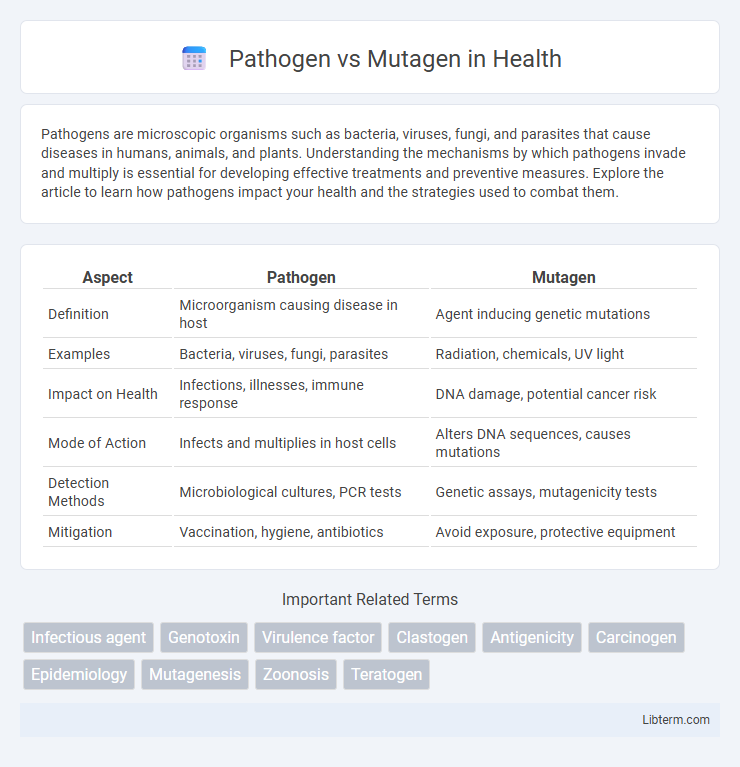Pathogens are microscopic organisms such as bacteria, viruses, fungi, and parasites that cause diseases in humans, animals, and plants. Understanding the mechanisms by which pathogens invade and multiply is essential for developing effective treatments and preventive measures. Explore the article to learn how pathogens impact your health and the strategies used to combat them.
Table of Comparison
| Aspect | Pathogen | Mutagen |
|---|---|---|
| Definition | Microorganism causing disease in host | Agent inducing genetic mutations |
| Examples | Bacteria, viruses, fungi, parasites | Radiation, chemicals, UV light |
| Impact on Health | Infections, illnesses, immune response | DNA damage, potential cancer risk |
| Mode of Action | Infects and multiplies in host cells | Alters DNA sequences, causes mutations |
| Detection Methods | Microbiological cultures, PCR tests | Genetic assays, mutagenicity tests |
| Mitigation | Vaccination, hygiene, antibiotics | Avoid exposure, protective equipment |
Understanding Pathogens: Definition and Types
Pathogens are microorganisms such as bacteria, viruses, fungi, and parasites that cause infectious diseases in humans, animals, or plants by invading the host's body and disrupting normal functions. Different types of pathogens include bacteria like Escherichia coli, viruses such as Influenza and HIV, fungi including Candida species, and protozoan parasites like Plasmodium, responsible for malaria. Understanding the mechanisms and classifications of pathogens is crucial for developing targeted treatments and effective disease prevention strategies.
What are Mutagens? Overview and Classification
Mutagens are agents that cause genetic mutations by altering the DNA sequence, which can lead to various biological effects including cancer. They are classified into physical mutagens, such as ultraviolet and ionizing radiation; chemical mutagens, including alkylating agents and base analogs; and biological mutagens, like certain viruses and transposons. Understanding mutagen classification helps in assessing risks associated with environmental exposure and developing strategies for genetic damage prevention.
Key Differences Between Pathogens and Mutagens
Pathogens are biological agents such as bacteria, viruses, fungi, and parasites that cause infectious diseases by invading living hosts, while mutagens are physical or chemical agents that induce genetic mutations in DNA. Pathogens actively replicate and can spread from host to host, whereas mutagens primarily cause alterations in genetic material without direct infection. Understanding the distinction is crucial for medical research and public health strategies targeting disease prevention and genetic damage control.
Mechanisms of Action: How Pathogens Affect Organisms
Pathogens affect organisms by invading host cells and disrupting normal cellular functions through mechanisms such as toxin production, immune system evasion, and cellular damage. Bacteria release exotoxins and endotoxins that interfere with cellular signaling, while viruses hijack the host's machinery to replicate, often triggering immune responses leading to inflammation. Fungi and parasites often destroy tissue or alter host immune responses, contributing to disease progression and symptom development.
Mechanisms of Action: How Mutagens Cause Genetic Changes
Mutagens induce genetic changes primarily by interacting directly with DNA, causing mutations through mechanisms such as base substitutions, insertions, deletions, or chromosomal rearrangements. Chemical mutagens often form adducts with DNA bases, leading to miscoding during replication, while physical mutagens like UV radiation cause thymine dimers that disrupt normal DNA structure. Understanding these mechanisms distinguishes mutagens from pathogens, which cause disease by infecting and replicating within host cells rather than altering genetic material directly.
Sources of Pathogens in the Environment
Pathogens originate from diverse environmental sources including contaminated water, soil, and air, as well as from infected animals and humans. Common environmental reservoirs for pathogens involve sewage systems, agricultural runoff, and decaying organic matter where bacteria, viruses, and parasites thrive. These sources facilitate the transmission of infectious agents, posing significant public health risks.
Common Sources of Mutagens in Daily Life
Common sources of mutagens in daily life include ultraviolet (UV) radiation from sunlight, tobacco smoke containing polycyclic aromatic hydrocarbons, and certain chemical exposures like those from pesticides, industrial solvents, and food preservatives. Mutagens cause genetic mutations that can lead to cancer and hereditary diseases by altering DNA sequences. Unlike pathogens, which are infectious organisms such as bacteria and viruses, mutagens are environmental or chemical agents that damage DNA without causing infection.
Health Impacts: Diseases Caused by Pathogens
Pathogens are microorganisms such as bacteria, viruses, fungi, and parasites that cause infectious diseases like influenza, tuberculosis, and malaria, significantly impacting public health worldwide. These organisms invade the host, disrupt normal physiological functions, and trigger immune responses that can lead to symptoms ranging from mild infections to severe systemic conditions. In contrast, mutagens are agents that induce genetic mutations, potentially leading to cancer and hereditary disorders, but do not cause infectious diseases directly.
Health Risks: Genetic Disorders Linked to Mutagens
Mutagens are agents that cause permanent changes in the DNA sequence, increasing the risk of genetic disorders such as cancer, hereditary diseases, and developmental anomalies. Unlike pathogens, which are biological organisms causing infections, mutagens directly alter genetic material, leading to mutations with potential long-term health consequences. Exposure to mutagens from chemicals, radiation, or environmental toxins significantly raises the incidence of genetic abnormalities and associated health risks.
Prevention and Control: Strategies Against Pathogens and Mutagens
Preventing pathogen exposure relies on rigorous hygiene practices, vaccination programs, and effective antimicrobial treatments to reduce infection rates. Controlling mutagens involves minimizing contact with known chemical agents, such as tobacco smoke and industrial pollutants, and implementing environmental regulations to limit radiation exposure. Both strategies emphasize early detection, public awareness campaigns, and continual monitoring to mitigate health risks associated with pathogens and mutagens.
Pathogen Infographic

 libterm.com
libterm.com